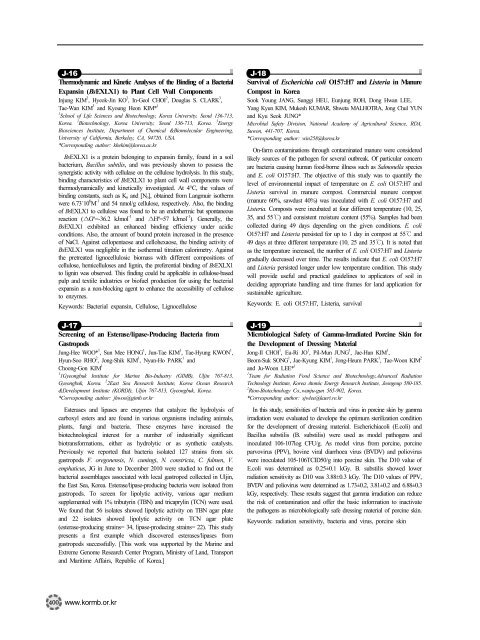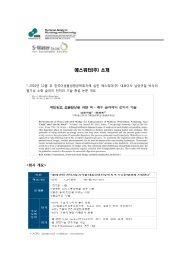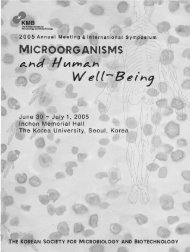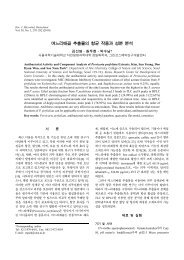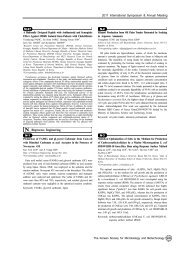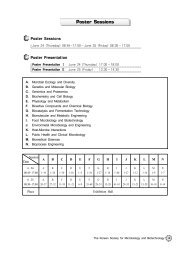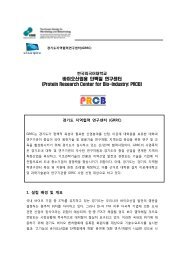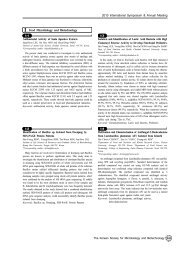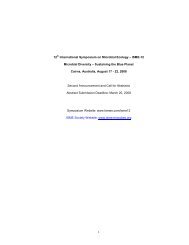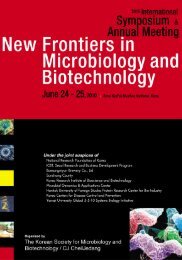J_Environmetal Microbiology and Engineering
J_Environmetal Microbiology and Engineering
J_Environmetal Microbiology and Engineering
Create successful ePaper yourself
Turn your PDF publications into a flip-book with our unique Google optimized e-Paper software.
Thermodynamic <strong>and</strong> Kinetic Analyses of the Binding of a Bacterial<br />
Expansin (BsEXLX1) to Plant Cell Wall Components<br />
Injung KIM 2 , Hyeok-Jin KO 2 , In-Geol CHOI 2 , Douglas S. CLARK 3 ,<br />
Tae-Wan KIM 3 <strong>and</strong> Kyoung Heon KIM* 1<br />
1<br />
School of Life Sciences <strong>and</strong> Biotechnology, Korea University, Seoul 136-713,<br />
Korea. 2 Biotechnology, Korea University, Seoul 136-713, Korea. 3 J-16<br />
Energy<br />
Biosciences Institute, Department of Chemical &Biomolecular <strong>Engineering</strong>,<br />
University of California, Berkeley, CA, 94720, USA.<br />
*Corresponding author: khekim@korea.ac.kr<br />
BsEXLX1 is a protein belonging to expansin family, found in a soil<br />
bacterium, Bacillus subtilis, <strong>and</strong> was previously shown to possess the<br />
synergistic activity with cellulase on the cellulose hydrolysis. In this study,<br />
binding characteristics of BsEXLX1 to plant cell wall components were<br />
thermodynamically <strong>and</strong> kinetically investigated. At 4°C, the values of<br />
binding constants, such as Ka <strong>and</strong> [No], obtained from Langmuir isotherm<br />
were 6.73´10 6 M -1 <strong>and</strong> 54 nmol/g cellulose, respectively. Also, the binding<br />
of BsEXLX1 to cellulose was found to be an endothermic but spontaneous<br />
reaction (∆Gº=-36.2 kJmol -1 <strong>and</strong> ∆Hº=57 kJmol -1 ). Generally, the<br />
BsEXLX1 exhibited an enhanced binding efficiency under acidic<br />
conditions. Also, the amount of bound protein increased in the presence<br />
of NaCl. Against cellopentaose <strong>and</strong> cellohexaose, the binding activity of<br />
BsEXLX1 was negligible in the isothermal titration calorimetry. Against<br />
the pretreated lignocellulosic biomass with different compositions of<br />
cellulose, hemicelluloses <strong>and</strong> lignin, the preferential binding of BsEXLX1<br />
to lignin was observed. This finding could be applicable in cellulose-based<br />
pulp <strong>and</strong> textile industries or biofuel production for using the bacterial<br />
expansin as a non-blocking agent to enhance the accessibility of cellulose<br />
to enzymes.<br />
Keywords: Bacterial expansin, Cellulose, Lignocellulose<br />
Screening of an Esterase/lipase-Producing Bacteria from<br />
Gastropods<br />
Jung-Hee WOO* 1 , Sun Mee HONG 1 , Jun-Tae KIM 1 , Tae-Hyung KWON 1 ,<br />
Hyun-Soo RHO 2 , Jong-Shik KIM 1 , Nyun-Ho PARK 1 <strong>and</strong><br />
Choong-Gon KIM 1<br />
1<br />
1Gyeongbuk Institute for Marine Bio-Industry (GIMB), Uljin 767-813,<br />
Gyeongbuk, Korea. 2 J-17<br />
2East Sea Research Institute, Korea Ocean Research<br />
&Development Institute (KORDI), Uljin 767-813, Gyeongbuk, Korea.<br />
*Corresponding author: jhwoo@gimb.or.kr<br />
Esterases <strong>and</strong> lipases are enzymes that catalyze the hydrolysis of<br />
carboxyl esters <strong>and</strong> are found in various organisms including animals,<br />
plants, fungi <strong>and</strong> bacteria. These enzymes have increased the<br />
biotechnological interest for a number of industrially significant<br />
biotransformations, either as hydrolytic or as synthetic catalysts.<br />
Previously we reported that bacteria isolated 127 strains from six<br />
gastropods F. oregonensis, N. cumingi, N. constricta, C. fulmen, V.<br />
emphaticus, JG in June to December 2010 were studied to find out the<br />
bacterial assemblages associated with local gastropod collected in Uljin,<br />
the East Sea, Korea. Esterase/lipase-producing bacteria were isolated from<br />
gastropods. To screen for lipolytic activity, various agar medium<br />
supplemented with 1% tributyrin (TBN) <strong>and</strong> tricaprylin (TCN) were used.<br />
We found that 56 isolates showed lipolytic activity on TBN agar plate<br />
<strong>and</strong> 22 isolates showed lipolytic activity on TCN agar plate<br />
(esterase-producing strains= 34, lipase-producing strains= 22). This study<br />
presents a first example which discovered esterases/lipases from<br />
gastropods successfully. [This work was supported by the Marine <strong>and</strong><br />
Extreme Genome Research Center Program, Ministry of L<strong>and</strong>, Transport<br />
<strong>and</strong> Maritime Affairs, Republic of Korea.]<br />
400 www.kormb.or.kr<br />
J-18<br />
Survival of Escherichia coli O157:H7 <strong>and</strong> Listeria in Manure<br />
Compost in Korea<br />
Sook Young JANG, Sunggi HEU, Eunjung ROH, Dong Hwan LEE,<br />
Yang Kyun KIM, Mukesh KUMAR, Shweta MALHOTRA, Jong Chul YUN<br />
<strong>and</strong> Kyu Seok JUNG*<br />
Microbial Safety Division, National Academy of Agricultural Science, RDA,<br />
Suwon, 441-707, Korea.<br />
*Corresponding author: win258@korea.kr<br />
On-farm contaminations through contaminated manure were considered<br />
likely sources of the pathogen for several outbreak. Of particular concern<br />
are bacteria causing human food-borne illness such as Salmonella species<br />
<strong>and</strong> E. coli O157:H7. The objective of this study was to quantify the<br />
level of environmental impact of temperature on E. coli O157:H7 <strong>and</strong><br />
Listeria survival in manure compost. Commercial manure compost<br />
(manure 60%, sawdust 40%) was inoculated with E. coli O157:H7 <strong>and</strong><br />
Listeria. Composts were incubated at four different temperature (10, 25,<br />
35, <strong>and</strong> 55℃) <strong>and</strong> consistent moisture content (55%). Samples had been<br />
collected during 49 days depending on the given conditions. E. coli<br />
O157:H7 <strong>and</strong> Listeria persisted for up to 1 day in compost at 55℃ <strong>and</strong><br />
49 days at three different temperature (10, 25 <strong>and</strong> 35℃). It is noted that<br />
as the temperature increased, the number of E. coli O157:H7 <strong>and</strong> Listeria<br />
gradually decreased over time. The results indicate that E. coli O157:H7<br />
<strong>and</strong> Listeria persisted longer under low temperature condition. This study<br />
will provide useful <strong>and</strong> practical guidelines to applicators of soil in<br />
deciding appropriate h<strong>and</strong>ling <strong>and</strong> time frames for l<strong>and</strong> application for<br />
sustainable agriculture.<br />
Keywords: E. coli O157:H7, Listeria, survival<br />
Microbiological Safety of Gamma-Irradiated Porcine Skin for<br />
the Development of Dressing Material<br />
Jong-Il CHOI 1 , Eu-Ri JO 1 , Pil-Mun JUNG 1 , Jae-Hun KIM 1 ,<br />
Beom-Suk SONG 1 , Jae-Kyung KIM 1 , Jong-Heum PARK 1 , Tae-Woon KIM 2<br />
<strong>and</strong> Ju-Woon LEE* 1<br />
J-19<br />
1<br />
Team for Radiation Food Science <strong>and</strong> Biotechnology,Advanced Radiation<br />
Technology Institute, Korea Atomic Energy Research Institute, Jeongeup 580-185.<br />
2<br />
Rion-Biotechnology Co.,wanju-gun 565-902, Korea.<br />
*Corresponding author: sjwlee@kaeri.re.kr<br />
In this study, sensitivities of bacteria <strong>and</strong> virus in porcine skin by gamma<br />
irradiation were evaluated to develope the optimum sterilization condition<br />
for the development of dressing material. Escherichiacoli (E.coli) <strong>and</strong><br />
Bacillus substilis (B. substilis) were used as model pathogens <strong>and</strong><br />
inoculated 106-107log CFU/g. As model virus from porcine, porcine<br />
parvovirus (PPV), bovine viral diarrhoea virus (BVDV) <strong>and</strong> poliovirus<br />
were inoculated 105-106TCID50/g into porcine skin. The D10 value of<br />
E.coli was determined as 0.25±0.1 kGy. B. substilis showed lower<br />
radiation sensitivity as D10 was 3.88±0.3 kGy. The D10 values of PPV,<br />
BVDV <strong>and</strong> poliovirus were determined as 1.73±0.2, 3.81±0.2 <strong>and</strong> 6.88±0.3<br />
kGy, respectively. These results suggest that gamma irradiation can reduce<br />
the risk of contamination <strong>and</strong> offer the basic information to inactivate<br />
the pathogens as microbiologically safe dressing material of porcine skin.<br />
Keywords: radiation sensitivity, bacteria <strong>and</strong> virus, porcine skin


